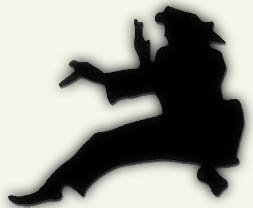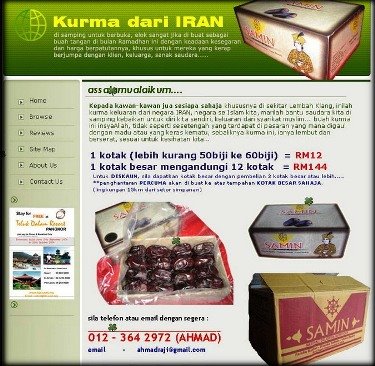RECENT POSTS
30 September, 2006
29 September, 2006
Proton Satria Neo Photoshops
More Proton Satria Neo-based photoshops by Theophilus Chin. Above is a sedan car based on the Proton Satria Neo, pretty much the same as before but this time in Iridescent White instead of the usual orange you see on most Satria Neo images. The bling turbine wheels have also been replaced with something similiar to the first wheel design featured on the Proton Waja. Anyway, two other body styles are after the jump.
Like the Chevrolet Optra has it’s brother the Optra Estate, Theophilus has given the above sedan a sibling in the form of this estate car. Estate, station wagon, it all means the same thing anyway.
Make the body larger, raise the suspension and you have an SUV! This is what Proton’s possible upcoming SUV could look like, if it carries Satria Neo design cues.
Copyright (C) 2003-2006 Paul Tan http://paultan.org
23 September, 2006
SILAT SENI GAYUNG MALAYSIA
| Majlis Mandi Minyak bagi Silat Seni Gayung Malaysia telah diadakan di gelanggang silat Gayung cawangan Langgar Limbung, Alor Star, Kedah. Di samping itu penyerahan Selendang Merah sebagai tauliah mengajar diadakan juga. Saksikan video " testing " gendang silat..... | |
CETAK NOMBOR CERMIN
| Ini ialah ciri-ciri keselamatan untuk nombor pendaftaran kenderaan (register number) yang dicetak pada cermin kenderaan tersebut. Ia begitu sukar untuk ditanggalkan. Tujuannya tidak lain tidak bukan, seandainya kenderaan hilang, manakala plat nombor telah dibuang oleh si pencuri, tetapi kita masih ada lagi pengecaman kenderaan kita dengan adanya ciri-ciri nombor keselamatan pada cermin kenderaan tersebut. Jika sesiapa berminat boleh datang berjumpa saya di Proton Edar Servis Alor Star (bersebelahan Toyota) Harganya tetap, iaitu RM30.00, mengambil masa 10 hingga 15 minit untuk disiapkan. Dicetak di cermin hadapan , cermin sisi belakang kanan , cermin sisi belakang kiri dan cermin belakang. | |
Steve Irwin Stingray Video
| Steve Irwin Stingray Death Video, EXCLUSIVE. Footage taken from a Police Storage Facility in Queensland, Austrailia. The Crocodile Hunter. | |
Martial arts
Martial arts are systems of codified practices and traditions of training for combat. Today, martial arts are studied for various reasons including combat skills, fitness, self-defense, sport, self-cultivation (meditation), mental discipline, character development and building self-confidence. A practitioner of martial arts is referred to as a martial artist.
Worldwide there is a great diversity of martial arts. Broadly speaking, martial arts share a common goal: to defeat a person physically or to defend oneself from physical threat. Within most martial arts there is a deep sense of spirituality. Every style has a different "feeling" that helps embody the martial art.
A common characteristic of martial arts is the systemization of fighting techniques. One common traditional method of training, particularly in the East Asian martial arts, is the form or kata (also called poomse, ch'ůan t'ao, kuen, tao lu, hyung, or tuls). This is a set routine of techniques performed alone, or sometimes with a partner.
Martial arts may focus on one or more of these areas:
- Striking (e.g. Boxing, Karate, Wing Chun, Krav Maga, Bando,Kapap,)
- Kicking, (e.g. Taekwondo, Savate, Capoeira, Lethwei, Tantui)
- Grappling and throwing (e.g. Wrestling, Shuai Jiao, Jujutsu, Judo, Pehlwani, Sambo, Naban, Aikido, Qin na, Kampfringen, Hapkido), or
- Weaponry (e.g. Iaido, Kobudo, Kapap, Naginata-do, Kendo, Fencing, Eskrima, Gatka, Banshay, Fechtkunst).
Some martial arts, particularly the traditional Chinese martial arts, also teach side disciplines such as bone-setting, Qigong, acupuncture, acupressure (Tui na), and other aspects of traditional Chinese medicine. Traditional Indian martial arts also teach aspects of traditional Indian medicine as side disciplines.
The martial arts, though commonly associated with East Asian cultures and people, are by no means unique to this region. For example, various Dravidian Indian martial arts, such as Kuttu Varisai, Varma Kalai, Kalari Payattu and Adithada, were developed in ancient Thamizhakkam (South India and Northeastern Sri Lanka). Savate was developed from Chausson and English boxing. Capoeira's athletic movements were developed in Brazil by slaves based on skills brought with them from Africa. English boxing was developed from bare-knuckle boxing.
Many martial arts also strive to teach moral values and provide guidance for children who join the ranks of those learning the art. Many arts require those who achieve black belt or the equivalent to take an oath restricting their use of their knowledge. Martial artists are also trained in mental and emotional discipline.
Martial arts in Malaysia
Pencak Silat or Silat ("fighting by using techniques of self-defence") is a Southeast Asian martial art with roots in the culture of the Malay World. This art is widely known in Indonesia, Malaysia, Brunei, and Singapore but can also be found in varying degrees among the Malay-affiliated countries of Thailand and the Philippines. The art has also reached Europe, and is especially popular in the Netherlands, where it is as popular as karate is in the United States. It is estimated that there are hundreds of aliran (styles) and thousands of schools. Many of the aliran find their origin in the observation of wild animals fighting. "Harimau" (Tiger) and "Helang" (Eagle) are some examples.Silat Seni Gayung (Gayong) Malaysia is the first silat martial arts association to be registered in Malaysia. It was founded by the late grandmaster Dato' Meor Abdul Rahman. He started to teach Silat Gayung at Sudong Island (now part of Singapore) during the Japanese occupation of Malaya in World War 2. Currently the highest ranking master is Mrs Siti Kalsom who holds the highest degree of belt and named heiress to the late grandmaster.
 The origin of Silat Gayong as taught by the late grandmaster and founder, Dato' Meor Abdul Rahman is from Silat Sendi Harimau which means The Tiger's Joint Silat. This is why characteristics of a tiger can be found in the style. It can be clearly seen in the logo of the silat and many physical movements such as Lompat Anak Harimau (which means the cub's leaping techniques). The hand always imitate the paw of a tiger and the verbal sound when practising combat techniqes sounds like the roam of a tiger.
The origin of Silat Gayong as taught by the late grandmaster and founder, Dato' Meor Abdul Rahman is from Silat Sendi Harimau which means The Tiger's Joint Silat. This is why characteristics of a tiger can be found in the style. It can be clearly seen in the logo of the silat and many physical movements such as Lompat Anak Harimau (which means the cub's leaping techniques). The hand always imitate the paw of a tiger and the verbal sound when practising combat techniqes sounds like the roam of a tiger.
Basically, to master Silat Seni Gayong, practitioners must learn at least 4 levels of out of seven stage of the silat. They are as follows:
1. Tapak Gayong (Foundation of Silat Seni Gayong - practitioners will study all techniques of self defence and offence using all parts of human body especially hand, leg, elbow, knee. No weapon is teach in this stage. Practitioners learn to use their bare hand as their weapon).
2. Seni Tapak Gayong (This is an advance form of the foundation. Practitioners will study in depth about the possible development of free-hand techniques in the Silat Seni Gayong).
3. Seni Keris (Learning how to apply defensive or offensive techniques using Malay dagger and other small sized weapons such as Kerambit, knife, tekpi)
4. Seni Simbat (In this stage, practitioner learns on how to apply defensive or offensive techniques using long weapons including spear, long stick, and parang).
5. Seni Yoi (Acrobatic techniques that are applicable to defeat stronger or bigger opponent. Silat practitioner will apply brilliant trap to ensnare their foes. Its approach is a cross breed between aikido and judo).
6. Seni Cindai (This technique applies ordinary clothes like kain sarung, belt, and tudung as weapon to defeat the opponent).
7. Seni Belian (Spiritual aspect of Silat Seni Gayong. Only Muslim practitioners who managed to achieve high level of discipline and dedication to Silat Seni Gayong have the opportunity to learn this technigue - normally senior instructors and future leaders of silat organizations).
Silat Gayong has 5 color belt ranking:
- Black (Junior)
- White
- Green
- Red (3 Stripes)
- Yellow (5 Stripes)
- Black (Senior) (6 Stripes), 7th Stripes cannot be obtain, it is late Grandmaster property
Why did he change the name to Silat Gayong? Well, Dato Meor lived in Ayer Kuning near Taiping (a small town in the state of Perak). As he was going to register his silat as an organised institution, he needed a comercialised name to go with it. In Taiping, the most famous term for silat is 'Gayung' or 'Bergayung' which means silat but in a more artistic way. So, in order to get recognision from the nearby society, he wisedly chose the name 'Silat Gayong Malaysia' Which also incorporates the name of the country it originates from Malaysia.
Since Gayong Malaysia Association is the first silat to set up an organization, it was easier to influence not only the public, but also schools, army forces, actors and even politicians.
Nowadays, Silat Gayung Malaysia is well-known not only in Malaysia, but also internationally. While the most famous Silat school it is not the only one in existence.
From Wikipedia, the free encyclopedia
BEWARE!!!!!
20 September, 2006
19 September, 2006
PETUA CEGAH BATU KARANG DARI PERINGKAT AWAL
Jika malam anda bersama dengan isteri (bersetubuh) , apabila membuang air kecil yang pertama (selepas bersetubuh) , anda hendaklah menutup lubang kencing di zakar anda (dengan jari) sehingga menjadi tekanan pada air kecil , kemudian lepaskan dengan mengejut air kecil tadi dan lakukan peneranan supaya air kecil tadi terpancut jauh (seperti tekanan bomba).
tujuannya ialah untuk membuang saki baki air mani di dalam saluran zakar. ia akan keluar bersama air kecil tadi.
Saya mendapat petua ini dari seorang guru agama yang warak,umurnya dah menjangkau 70 tahun tetapi masih cergas, badan kecil sahaja dan mempunyai tanggungjawab lebih iaitu beristeri dua..
Beramallah moga tuhan memberi kesihatan kepada kita..





